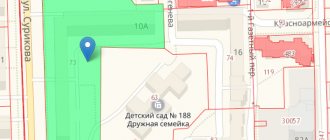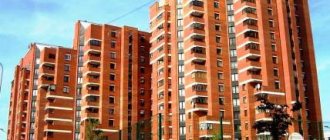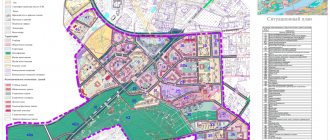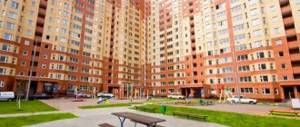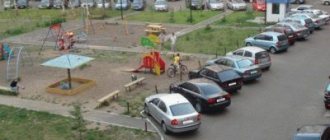When purchasing an apartment, its owner is sure that all rights to the purchased meters belong exclusively to him. But few people think about what happens to the land and the real estate located on it, which is located next to the apartment building.
The adjacent territory is the territory adjacent to a residential building, defined by land management and urban planning documentation within a plot of land of a certain area.
It may contain various structures and non-residential premises necessary to meet the household needs of the residents of this house. Many people are interested in the question of how many meters is the adjacent area of an apartment building in 2021? Read more about this below.
Home improvement and local area
There are no specific standards regulating the exact size of the local area. On average, for an apartment building this equates to 3-6 meters (maybe more).
According to Art. 36 Housing Code of the Russian Federation, the local area includes :
- blind areas (waterproof coverings located around the building);
- driveway, sidewalk, planting strip along the house, as well as the one located near the facade without entrances (its purpose is to provide passage for fire trucks);
- children's playgrounds, sports grounds, as well as those pedestrian paths (paths) that connect these objects to each other;
- areas where waste bins are located;
- plots of land under non-residential commercial buildings and structures;
- parking lots where the cars of residents of an apartment building are parked;
- exits, entrances to underground garages and parking lots.
How many meters from the fence is considered private property?
On the other hand, if there are no various communications on it, everyone can use this territory at their own discretion, namely, organize a beautiful lawn or flower garden, a playground for children using various complexes, such as swings or sandboxes, or organize an entrance for a personal car, which can can also be used for special vehicles.
The article details how many meters from the fence are considered private property. If they have a privately owned house, cottage or dacha, people often have a question about how many meters from the fence can be considered private property.
Registration of property
The only legally accessible and legal option for privatizing the adjacent territory today is the organization of condominium associations (associations of co-owners of an apartment building). It is important to understand that after drawing up the agreement, it does not become the property of the condominium association, but belongs to all co-owners of the apartment building in equal shares.
The condominium association is a legal entity, a non-profit organization, the main objectives of which are to improve the quality of provided public services, manage an apartment building, and rationally operate shared facilities for residents.
The sequence of transferring land into the ownership of condominiums:
- At a meeting of residents, an appropriate decision is made on the privatization of the land around the house;
- Next, you should contact Rosreestr with an application to register ownership;
- When the permission to allocate a land plot and the corresponding technical specifications are ready, you need to go to the land management organization with a package of documents.
How to hold a general meeting of residents in 2021?
What documents will be required:
- certificate of state registration of condominiums;
- the charter of this organization;
- certificate of inclusion in the All-Russian Classifier of Enterprises and Organizations (OKPO);
- technical passport for an apartment building;
- extract from the state register of ownership;
- decision of the members of the condominium association to transfer the adjacent territory to private use;
- land boundary plan.
In turn, the land management organization, based on the land division project and the documents provided by the condominium association, prepares a site allocation project. Next, the city council must decide to transfer the territory near the house to the ownership of the residents of the apartment building and approve the corresponding project.
Based on the results of all the decisions made, the boundaries of the site are drawn to the area, after which a state act on the ownership of residents of the land adjacent to the house is drawn up and entered into the Unified State Register of Rights to Real Estate.
Registration of condominiums and selection of relevant documentation are energy- and financially-intensive activities. However, this procedure has several advantages:
- Residents can independently dispose of the corresponding plot of land, monitor (adjust) the amount of payment for cleaning the local area.
- Privatization allows you to avoid unwanted buildings in the relevant area and use the territory for the needs of the residents of the apartment building.
Who owns the land behind the fence of a private house
I have 1/2 of a private house, received by inheritance. The plot on which the house stands was divided by court with neighbors who own the other half of the house. The side of the plot facing the intra-block passage was divided by the court into 9m and 11m between me and the neighbors, respectively.
The scandalous neighbor claims that the territory behind the fence over these 11 meters is his property and buried the ditch that I dug for drainage. I believe that the territory behind the fence belongs to the municipality and is no one’s private property. Am I right and what should I do with my arrogant neighbor? Where should I go?
We recommend reading: AOO check investment fund MN fund share price
Dimensions and rules for using the local area of private residential buildings
When drawing up an agreement with the company to which the work is entrusted, it is worth stipulating exactly what stages will be carried out. Installing a barrier Often, the recreation area near houses in the city center turns into parking for other people's cars, especially near markets. As a result, residents face additional inconveniences.
If the roads are through, you are guaranteed additional problems. The air will be smoky. The streets near such houses are noisy. There are oil stains on the road surface. And children can get run over by a car.
In addition, residents have nowhere to park their vehicles. Is the situation familiar? There is a solution to this problem - install a barrier at the entrance to the yard. It is necessary to adhere to the conditions prescribed by law. The first thing that is required is to be the owner of a plot near an apartment building.
Who owns the territory behind the fence of a private house?
- Significant communication lines are laid along the desired territory;
- The transfer of a plot of land into the possession of the owner will entail a change in the negative direction of the width of the street space by an indicator less than permissible (we denote that the width of the streets should not be less than 15 meters for local significance and 40 meters for the main value, respectively);
- When the location of the site takes place in an area of historical and cultural significance;
- Provided that other owners have property rights in relation to this plot of land, and their consent, accordingly, is absent.
We recommend reading: Supplement to pensions for military veterans in 2021
I had to call a friend to come up to the guards, but in the end my friend had an argument with them and they let me through. As I know, residents of houses who park their cars near the house (there are cameras throughout the territory) pay 50 rubles per day for this, which is included in the payment receipt.
Basic Concepts
First of all, we will define what should be understood by the local area, since this concept is not included in the regulations.
A home area is a plot of land owned by a person, adjacent to the house and used by the owner in his own interests.
Thus, a house plot is a part of a land plot that directly borders the house. The owner of the plot is obliged to maintain the local area, namely:
- the surrounding area must be cleared (from snow, leaves, dirt, etc.);
- the owner or tenant of the land must ensure the possibility of unhindered passage (passage) to the local area (for rescue vehicles, ambulances, fire departments, etc.);
- It is prohibited to install poles or signs on the territory (in some cases it is possible to install signs or additional lamp posts with prior approval);
- it is necessary to ensure the safety of communications laid on the territory of the local area (gas, sewerage).
However, the local area can be used, but with restrictions. The owner can plant various shrubs and lay out a lawn. Very often, sand is unloaded onto the local area for a children's playground. If the sandbox is small, then most likely there will be no complaints. But the territory should not be littered with construction materials and garbage. In the local area you can install a children's swing, pave asphalt, and make a convenient driveway for cars.
Standards for the use and responsibilities for maintaining the local area can be approved in local regulations. For example, in the rules for improvement of a city or region. Using the example of the private sector, an obligation may be established to mow the grass around the house (the area behind the fence - the local area), and clear snow within a radius of 3-10 meters.
The Code of Administrative Offenses stipulates cases when a fine is imposed on the owners of the territory:
- for violation of landscaping rules;
- for unauthorized occupation of a land plot if there are foreign objects in the local area for a long time, including building materials, garbage, equipment, etc.
However, these offenses (the fact of commission or failure to fulfill duties) can be challenged in many cases: the local area, if it is not registered, is not someone’s property specifically, therefore the person who is facing a claim for violating the norms of the Code of Administrative Offenses of the Russian Federation can challenge the fact of committing offenses.
Moreover, there are cases when the violation is charged to individuals for well-intentioned “offenses.” For example, owners of private houses plant alleys along the road to protect their area from noise and dust. This may be regarded by the administration as unauthorized use of the territory, so it is better to first coordinate tree planting with local self-government authorities. How to measure the area of the local area
The size of the local area can be established by municipal authorities, because this issue is not regulated at the federal level. If we evaluate the adjacent areas, their size does not exceed 2-6 square meters from the installed fence.
In general, to determine the area of a local area, you can be guided by the following list of documents:
- Land Code of the Russian Federation.
- Civil Code of the Russian Federation.
- Town Planning Code.
- A registration certificate for the house and a cadastral plan for the land plot.
- Federal Law “On the State Real Estate Cadastre”.
To indicate the boundaries of the adjacent plot of an apartment building, you can use the formula (Sn=Sr*Ypz), which is based on data on the area of a residential building (Sr) located on the plot, and the indicator of the land plot (Ypz), which is determined in accordance with SNiP ( data taken into account at the time of construction of the house).
The above formula is not suitable for a private house, so the calculation of a house plot in the private sector looks different. To determine its area, you need the following:
- Draw up a plan of the territory of the house indicating the boundaries and located construction sites.
- Indicate on the plan the part of the municipal land (domestic area) adjacent to the fence.
- Contact local government authorities to register the local area (determining the area of use and the basis for using the land).
Thus, the adjacent plot can be attached to your own plot by carrying out land surveying. Subsequently, the plot is registered either as a property or as a long-term lease.
Who owns the land behind the fence of a private house
It should be noted that the legislation establishes only the minimum and maximum sizes of plots allocated for the construction of a house in rural settlements and urban-type settlements - from 0.15 to 0.25 hectares inclusive.
We recommend reading: How to sell land received to a large family that was given to a large family by children who are already adults
2) other premises in this house that do not belong to individual owners and are intended to meet the social and everyday needs of the owners of premises in this house, including premises intended for organizing their leisure time, cultural development, children's creativity, physical education and sports and similar events;

